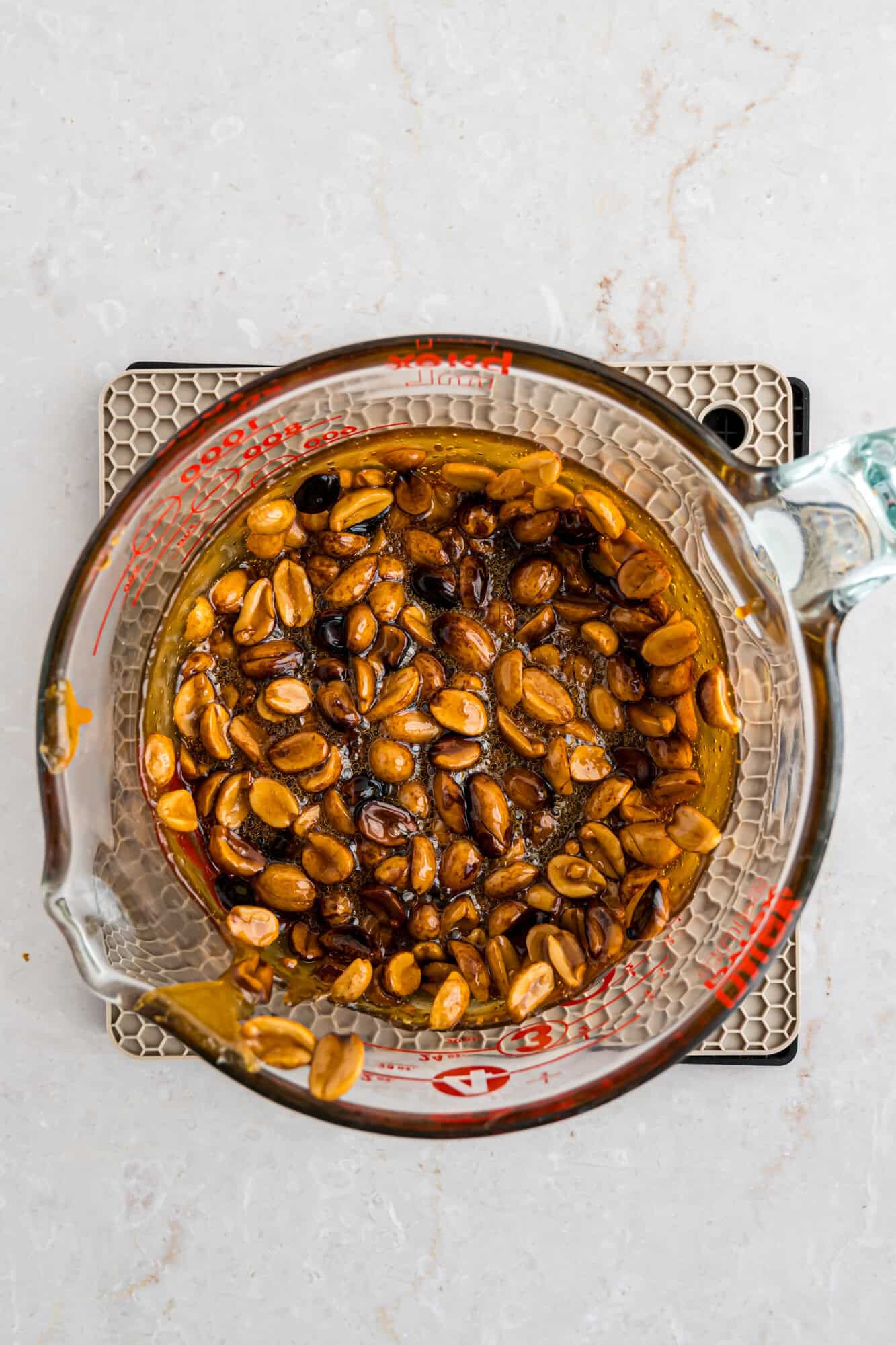Peanut Brittle Recipe
Recipe Overview
Why you’ll love it: Classic peanut brittle is everyone’s favorite treat! You may be surprised at how simple this candy recipe is to make.
How long it takes: about an hour, including time to cool the brittle
Equipment you’ll need: large saucepan, large sheet pan, candy thermometer, parchment paper
Servings: makes about 16 oz. of candy

Pin this now to find it later
Who doesn’t love homemade peanut brittle?! Crisp, sugary, loaded with peanuts, it’s a perfect snack. One of my friends gives me a bag of her homemade peanut brittle every Christmas and I’m telling you, it’s a treat I look forward to every year!
Homemade Peanut Brittle
Easier to make than you might think. Sometimes making candy seems a little intimidating or tricky, and you might feel it’s better left to the “experts”. I’m here to tell you that you can do it! The ingredients are pretty simple and the actual hands-on cooking time is less than a half hour.
Totally (addictively) delicious! There’s really nothing quite like homemade peanut brittle. It’s perfectly balanced between sweet and salty, with so much fresh peanutty flavor and just the right crunch. If you happen to buy peanut brittle, it’s often so disappointing, with stale peanuts or super-hard brittle. This homemade peanut brittle recipe will not disappoint!
Makes a great gift. Everyone will welcome a bag of your homemade peanut brittle. Wrap it in a pretty cellophane bag, with a ribbon tied around the top, as a Merry Christmas treat. Peanut brittle is also a great addition to cookie platters.

Ingredient Notes
- Roasted Peanuts: You’ll need a cup and a half of dry roasted peanuts. I’ve found that lightly salted peanuts work better than the regular salted peanuts. Some folks prefer raw peanuts, blanched peanuts, or Spanish peanuts for their peanut brittle. I haven’t tested the recipe with any of those but feel free to give them a try if you want.
- Sugar: Regular white granulated sugar is the sugar of choice for peanut brittle. You might think that since the brittle looks golden brown, you would use brown sugar. However, you’ll find that as the white sugar cooks, it turns golden brown as it caramelizes.
- Light Corn Syrup: Usually you can find bottled corn syrup in the baking aisle. It’s clear with no color and is often used in candy-making. A common brand name is Karo syrup.
- Butter: I always choose unsalted (sweet) butter for cooking and baking. It’s best if the butter is at room temperature.
- Vanilla: There isn’t a lot of added flavor to peanut brittle other than the vanilla. Be sure to use a good quality pure vanilla extract, not imitation vanilla.
- Baking Soda: This baking essential is absolutely necessary when making peanut brittle. It causes a chemical reaction when you add it, causing the hot liquidized sugar to foam up. Without it, the brittle would be too hard to bite into.

How to Make Peanut Brittle
Get ready. When you’re making a candy recipe, it’s important to have everything ready to go. To make peanut brittle, you’ll need a medium-sized, heavy-bottomed saucepan, a large sheet pan (preferably with a rim), and a candy thermometer. Line the sheet pan with parchment paper or grease it lightly with butter. I prefer parchment paper because it won’t leave a greasy film on the peanut brittle.
Measure out the ingredients. Again, you’ll want to have every ingredient measured and ready to go. The sugar, corn syrup, and a quarter-cup of water can be put right into the saucepan. Measure the remaining ingredients (peanuts, butter, baking soda, and vanilla) and set them aside for now.
Cooking Tip
Lightly spray the inside of the measuring cup with nonstick spray before measuring the corn syrup. The corn syrup will slip right out of the cup into the pan!
Cook the sugar mixture. Over medium-low heat, bring the sugar, corn syrup, and water to a gentle rolling boil. The surface of the mixture should be covered with bubbles. Once the mixture comes to a boil, don’t stir it. This is important because stirring can cause the liquid sugar mixture to crystallize. Now is a good time to clip the candy thermometer on the edge of the pan. As the sugar cooks, the color will change from a white opaque color to a clear yellowish tint. Cook for 10 to 12 minutes or until the candy thermometer registers 250℉.


Add the peanuts. Reduce the heat to low. Stir in the peanuts, and continue to heat the mixture over low heat. Don’t try to hurry the process; the peanuts tend to scorch with higher temperatures. Cook the mixture for about 10 more minutes, stirring occasionally to prevent the peanuts from sinking to the bottom, until the temperature reaches 300℉ (hard crack stage).
Add remaining ingredients. Remove the pan from the heat and immediately stir in the cubed butter, baking soda, and vanilla. The mixture will foam up.


Spread onto sheet pan. Immediately, pour the contents of the saucepan onto the prepared baking pan. Spread the peanut brittle mixture into a thin layer, about one-quarter inch thick. Don’t worry if it seems to separate; the mixture tends to level itself out somewhat.
Cool and break into pieces. Set the peanut brittle aside to cool for at least 30 minutes. Once it’s cool, break it into pieces. Cool completely before packaging.
Helpful Tips
Prepare ahead of time. As I mentioned above, it’s important to have everything ready to go before you get started with the cooking. If your sheet pan isn’t ready, the mixture will harden in the saucepan while you’re getting it ready, and then it won’t spread anymore. You’ll have a peanut brittle lump.
Measure carefully. There are some recipes where you don’t have to be terribly exact when you measure ingredients. This is not one of them. Candy-making is somewhat of a science and it’s important to be accurate or your brittle may not turn out.
Know when to stir. Once the sugar/syrup/water mixture begins to boil, it’s going to be tempting to stir it once in awhile. Don’t! Stirring at this point may cause the sugar to crystallize and the peanut brittle may turn out grainy. Once you add the peanuts, you do need to stir occasionally to keep the peanuts from sinking to the bottom and possibly scorching.
Cut the butter. I’ve found that cutting the butter into small pieces works best because it melts more quickly once you add it to the candy mixture. You don’t want the brittle to harden before you can incorporate the butter. Add the butter all at once to the pan, along with the vanilla and baking soda.
What Is Hard Crack Stage?
There are various stages in candy-making that can be measured on a candy thermometer. Peanut brittle needs to be cooked to hard crack stage, 300℉ to 310℉. If you don’t have a candy thermometer, you can use the cold water method to test it although this method is not as reliable. When the mixture is at hard crack stage, the bubbles on top will become smaller and closer together. Drop a little of the mixture into cold water. It should form brittle threads that crack when you bend them.
Nut Brittle
If you’re not a fan of peanuts or would like to try something different, consider using a different type of nut. Any roasted, lightly salted nuts of your choice will work. We like cashews, whole almonds, or mixed nuts. You can also make the brittle with walnuts or pecans. For the best flavor, toast the walnuts or pecans lightly before adding them (see how to toast pecans or how to toast walnuts). Be sure to check out my recipe for walnut brittle with holiday spices.
Once the peanut brittle has completely cooled, and is broken into pieces, store in a covered container or resealable bag. I’ve found that it’s best to store it at room temperature. Refrigerating or freezing peanut brittle changes the texture and may make it sticky or chewy instead of crisp.
This peanut brittle recipe will stay fresh for up to three weeks. Store it in a location away from heat and light, such as your pantry.

After the peanut brittle has cooled, break it into pieces. Be sure it’s completely cool before packaging it. Fill clear cellophane bags with the desired amount of peanut brittle candy, tie a colorful ribbon around the tops of the bags, and store at room temperature until you’re ready to give the gifts. It’s best if you don’t mix the peanut brittle with other types of candy treats in the same bag.
Line a rimmed baking sheet with parchment paper, or lightly grease the pan with butter. Set aside. Measure out all the ingredients. It’s important to prepare the baking sheet and to have all the ingredients measured and ready to go so that you can move quickly.
Add sugar, corn syrup, and water to a medium, heavy-bottomed saucepan. Stir to combine.
1 cup granulated sugar, ½ cup light corn syrup, ¼ cup water
Over medium-low heat, bring to a gentle rolling boil (the entire surface is covered with bubbles). The mixture will have a white, opaque appearance at first. Once the mixture starts to boil, don’t stir it. Stirring before reaching 250℉ can cause crystallization of the brittle. As it approaches the 250℉ mark, it will turn clear and have a yellowish tint. This process will take about 10 to 12 minutes. Use a candy thermometer to measure the temperature.
Turn the heat to low. Add the peanuts and stir the mixture to incorporate them. After adding the peanuts, keep heat LOW. Resist the urge to turn up the heat. Otherwise, the temp will rise too quickly, and you risk burning the brittle.
1 cup lightly salted, dry roasted peanuts
Continue to cook over low heat until the temperature reaches 300℉, stirring occasionally to prevent the peanuts from settling to the bottom and burning. This will take about another 5 minutes. As the temperature rises, the color of the brittle should become more caramel-colored.
Remove the pot from heat and quickly stir in the cubed butter, baking soda, and vanilla.
2 tablespoons unsalted butter, cubed, 1 teaspoon baking soda, 1 teaspoon pure vanilla extract
Immediately pour the peanut mixture onto the parchment-lined baking sheet and spread to a thickness of about ¼ inch. When you are spreading the peanut mixture onto the baking sheet, it might appear to be separating. However, as you spread it, it will hold together and level itself out.
Let the peanut brittle cool for 30 minutes. Break into bite-sized pieces.
- Butter: Cubing the butter helps incorporate all the ingredients quickly before the sugar mixture hardens. You’ll find that the process goes much better if the butter is in small pieces.
- Peanuts: I prefer LIGHTLY salted peanuts in the brittle. The regular salted ones seem to have a weird coating that gives the brittle an orange tint.
- Storage: Once the peanut brittle has cooled completely, store in an airtight container or resealable bag at room temperature for up to 3 weeks. Do not refrigerate or freeze the brittle; it will change the texture and make it chewy.
Serving: 1oz., Calories: 147kcal, Carbohydrates: 23g, Protein: 2g, Fat: 6g, Saturated Fat: 2g, Polyunsaturated Fat: 1g, Monounsaturated Fat: 3g, Trans Fat: 0.1g, Cholesterol: 4mg, Sodium: 114mg, Potassium: 61mg, Fiber: 1g, Sugar: 21g, Vitamin A: 44IU, Calcium: 8mg, Iron: 0.2mg
Nutrition information is automatically calculated, so should only be used as an approximation.



